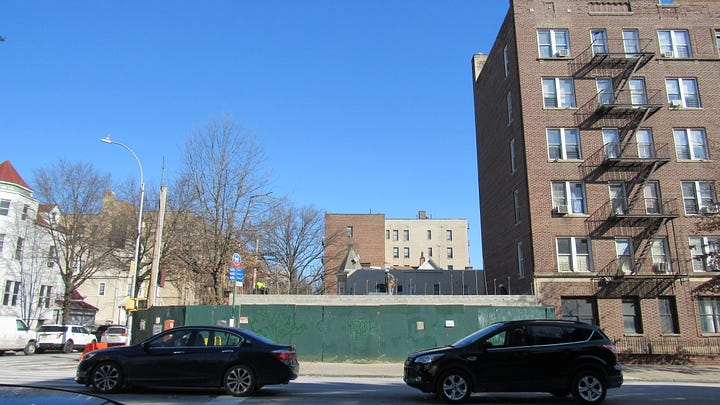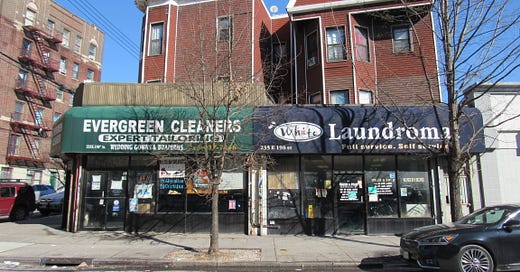Welcome to Bronx Frontlines—stories from the Dominican diaspora
The Bronx is the epicenter of NYC’s—and America’s—Dominican population.
When I was eleven, my mother worked at Clean & White Laundromat on 198th street between Valentine and Briggs Avenues. I loved its machines, dryers, carts, the long rows of folding tables placed vertically down the center of the laundromat, from the front to the back, and the empty spaces between them. My mom loved her job as a store attendant. I recall how happy and confident she seemed. She spoke Spanish to different people daily, moving and talking as she folded shirts, pants, and towels, exchanging dollars for quarters, or meticulously arranging detergent bottles on the counter.
The smell of drying laundry still calms me years later. It reminds me of the Bronx and my mom then, how she existed and blossomed in the physical space of Clean & White, and how much she relished holding and controlling the material things inside that space. Years later, she tells me how much she loves work that allows her to move her body, work that gives her routine and control.
Clean & White is still there when I move back to the neighborhood in June 2022. The community was and still remains boisterous, fun, and full of life.
Back then, I spent hours people-watching and playing on the streets outside these storefronts. Up the block from the laundromat was the salon where the women in my family relaxed and blew out our hair. The fruit market next to it, owned by the father of a school classmate, sold my favorite candy, Spice Girls lollipops. Across the street from the market was the record store where I purchased albums and videos and lusted after the teenage store clerk. To the left of the record shop was the store where my mother bought me a Luz Clarita purse that featured the titular character's face on a medium, square-sized plastic bag; and to the right was Lena's, the restaurant that sold my favorite tacos.
Clean & White, Lena's, and a few other shops, remain, as well as many of the homes, schools, and churches on or around 198th, including Our Lady of Refuge, Academy of Mount Saint Ursula, Saint Philip Neri, and P.S. 008 Isaac Varian. Almost all the stores my family patronized are no longer here.
Throughout Norwood and Bedford Park, there are empty lots and buildings in different stages of construction. All are closed off from the community by dark green, tall fences. Nearby, scattered on poles, are posters, stickers, and signs featuring a variation of "Call this person to sell your house! We will buy in ANY CONDITION! Cash!" No buyer names or companies are included, just numbers.


Prices are also rising across the Bronx for food, healthcare, and rent. Research done by student reporters with the City Limits Accountability Reporting Initiative For Youth finds that the borough's "median rents for a one-bedroom rose 14 percent from $1,650 in August 2019 to $1,900 [in August 2022.] Two-bedrooms increased by 20 percent from $2,000 to $2,400." As of 2022, the Bronx has the highest eviction rates in the city, and our borough faces higher rates of food insecurity. Just last month, nurses at Montefiore Hospital, one of the Bronx's largest employers and the leading healthcare provider for many Norwood and Bedford residents, went on strike demanding better staffing and care for its Bronx patients.
The material needs of this community are not met. We work for food and shelter, all while living through the collective devastation of COVID-19. It is expensive to eat, have a home, and have our bodies cared for—to exist. Landlords collude against us, white gentrifiers continue to displace us, and police continue to surveil us.
Officers in cars watch when we are gathered outside our residential buildings; when we worship in church spaces; when we patronize our local food shops; when we protest; when we walk and play and party in our parks and green spaces. All while the state continues its violence, from the forced incarceration policy of the Adams administration to the billion-dollar NYPD budget to pro-landlord legislation to the slashing of budgets for food stamp offices and public libraries.
The signs of our violent and systemic displacement are here, but these are Black and Brown communities, still.
On the Bronx, then and now.
The borough is the third most densely populated county in the United States and has the most green spaces in all of New York City, with nearly a quarter of the Bronx's square mileage consisting of green space. As of 2020, the Bronx is home to 1,472,654 people. More than 50% of Bronxites identify as Latino.
"Dominicans in the United States: A Socioeconomic Profile," a 2022 report by Ramona Hernandez, Francisco L. Rivera-Batiz and Sidie S. Sisay at CUNY's Dominican Studies Institute, states that the Bronx is the epicenter of NYC's—and America's—Dominican population, with almost 50% of us living here. “The Dominican population in the United States has grown at a faster rate than the rest of the population in the country and it has not slowed down in recent years, rising from 1,041,910 in 2000 to 1,537,558 in 2010 and 2,216,258 in 2020, making it the fifth-largest Hispanic/Latino group in the United States, after Mexicans, Puerto Ricans, Salvadoreans and Cubans.”
The Bronx is the epicenter of NYC's—and America's—Dominican population, with almost 50% of us living here.
The Dominican diaspora, squarely grounded in a global, African one, consists of 2,500,000 Dominican emigrants in the Caribbean, North America, and Europe, in countries like Puerto Rico, Canada, Chile, Venezuela, and Switzerland. Most of us migrate to the United States, home to 2,080,000 US Dominicans. As of 2020, the report states, after the Bronx, 43,068 Dominicans live in Paterson, New Jersey; 39,993 in Boston, Massachusetts; 38,818 in Providence, Rhode Island; 34,352 in Lawrence, Mass.; 33,681 in Philadelphia, Pennsylvania; and 29,948 in Yonkers, NY.
Records of our migration from the island to the United States date back to the 17th century. Significant numbers begin in the 1960s, with more considerable mass migration starting in the 1970s. Over 90% of Dominicans who arrived in NYC in the second half of the 20th century settled in Washington Heights. By 2020, only 24% of the Dominican NYC population lives in Manhattan.
When my parents moved here in the early '90s, the Bronx was home to 1,203,789 New Yorkers, with around 500,000 Dominicans. They arrived first, and then slowly, their siblings, their daughter, and their siblings' kids followed. The city was so hard for them, for us all. We were poor, immigrants, Caribbean, many of us undocumented, and trying to survive in 1990s New York City. We were also together, and we laughed and danced and partied and played often.
I do not remember a life before the Bronx or a life before displacement and migration shaped by foreign intervention, colonialism, imperialism, capitalism, chattel slavery, patriarchy, indigenous genocide, and Christianity. We internalize these systems from the moment we are born, including in our most intimate relationships; we are colonized physically, mentally, spiritually, and emotionally.
White supremacy teaches us to devalue how we love, survive, live, and worship under these systems, so I devalued what and who I loved growing up. I devalued my city and my community. I craved what I perceived as the superiority of whiteness. White people were more brilliant, more beautiful, and more eloquent. This is how whiteness is internalized. It teaches us that we are small because the spaces we can occupy are small, underfunded, and under-resourced. We are more than whiteness. We are worthy, beautiful, and loved. We are all these things and more despite oppressive systems.
Bronx Frontlines is a project about Dominican displacement and the various ways it shows up in the lives of Dominican women, and the various ways we survive and resist oppression.
My writing, a mix of reporting, essays, and cultural reviews, will focus on why Dominicans leave the island and how this move shapes us, individually and collectively. I want to know why my parents, like so many before and after them, chose to depart their cities of birth, and their entire families, for the United States; and why 30 years later, as they prepare for retirement, they still choose the USA over their motherland. How did they gather and organize to meet their survival needs and the needs of those in their care and those in their communities? How did they resist?
I will write about these stories of resistance while also learning and analyzing Haitian and Dominican history. To understand the Dominican Republic and Haiti is to understand the formation of the colonized Americas and the American empire.
In The Dominican Americans, Ramona Hernández and Silvio Torres-Saillant write, "the Dominican Republic is at the core of the Caribbean historical experience despite the fact that it is seldom viewed along with other members of the West Indian family." They add that what makes up modern-day D.R. "witnessed the first settlement of Europeans, the first genocide of aborigines, and the first cohort of African slaves in the archipelago. Santo Domingo initiated racial mixture, religious syncretism, linguistic nativization, and the overall creolizing process that typifies Caribbean culture." Every part of our history is intimately connected to the next, from Arawak/Taino migration and genocide to French and Spanish colonialism to African enslavement and displacement to the Haitian revolution and unification with D.R. to U.S. invasion through Trujillo and Balaguer to migration to New York City and back.
Bronx Frontlines is rooted in this history, and in the work of Dominican women scholars who taught and wrote through these questions and histories before me and who gave me theory and praxis and questions before I even knew I needed either, in particular Zahira Kelly-Cabrera. Kelly-Cabrera, more commonly known by her handle, Bad Dominicana, is an Afro-Dominican mujerista, sociocultural critic, speaker, artist, and D.J. I have followed and learned so much from her on Twitter. Last month, she launched “Tu Supite,” a bilingual podcast with Alejandro Pé. The podcast offers “a proBlack anticolonial look into invisibilized Black women/queer life in DR, + featuring proBlack guests who are figures in those areas.”
Bronx Frontlines is for our stories, histories, fiction, and reporting. It is about our resistance.






